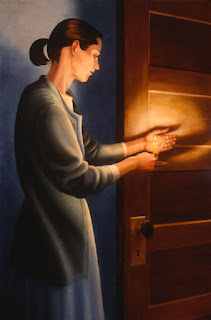Secret Visit of the Broken-hearted Man, 1995. Oil on canvas, 60x48".
I recently had the honor of jurying the 21st Annual Student Art Exhibit at the University of Montana. I was confronted there by 97 works of art from which to select not only the exhibition, but eleven awards. This was both a fascinating and consuming task. The drawings and paintings, sculptures, prints and photographs consistently raised questions for me. In an effort to understand the artists' intentions, I turned to the submission forms, seeking titles. Titles, I believed, might answer some of my questions, guide my consideration. What I discovered, over and over again, was "Untitled".
One for Sorrow, 1999. Oil on canvas, 27x27".
I do not fault artists for leaving work untitled. There are philosophical and pragmatic reasons why one may not give a name to a work of art. (This might be particularly true for art generated under instruction.) It can be hard to come up with a strong verbal image to accompany every visual image into the world. But that's what titles are, verbal images that provide another opportunity to express the artist's motivations and meanings.
Scavengers Trio, 2014. Graphite & oil on wood panels, 66x12".
Titles have become practically important to me. With an archive of nearly 2000 images, a name is easier to call up or track down than "Untitled I, V, L, CXVI, CMVII....". But more significantly, titles can help steer interpretation. The name of an art work can offer clues to the artist's central interests and interpretation. Even in process, having something to call a piece fosters a sense of relationship to the work particularly -and in the broader scope of my endeavor.
Red Flag, 2015. Graphite & oil on wood panel, 18x24".
I've come to believe there is an art to titling. Artists can be descriptive, simply giving the image an identity. Artists can also use titles to signal a way of looking at and ultimately understanding a work of art. Titles can also help us contextualize images culturally, linking them to collective myths and symbolism. And rather than give the interpretation away, titles can be used to add to the mystery and elusiveness of visual imagery. I've embraced titles as a way of deepening intimacy with my own work, and with hope that they also help to draw viewers closer too.
Cherisher or Light & Collector of Possibilities, 2000. Oil on canvas, 30x20".
Lover of Time & Student of Loneliness, 2000. Oil on canvas, 30x20".
.








So interesting to read your views on titles. And even though a poem is made of words, the title is so often a clue in the way you describe. Also, sometimes very difficult to generate.
ReplyDeleteThank you Stephanie. You are right. I think it's fun to title something. It can be poetic, and is a great way to add context and meaning or insight to a piece.
ReplyDelete